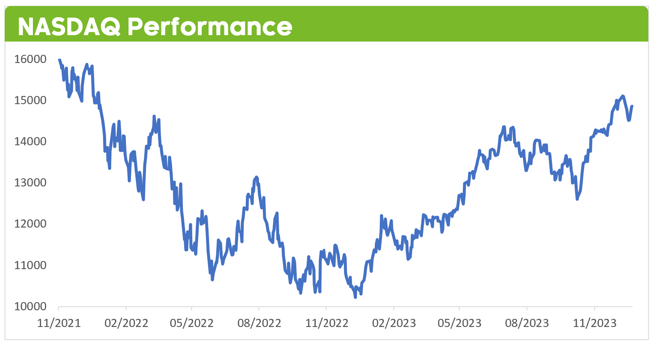Recession obsession
In 2023, the market defied expectations as it rebounded from the anticipated recession that never materialised. Investors, expecting a downturn due to an unprecedented rate-hiking campaign, were caught off guard.
The technology sector is often vulnerable to rising interest rates because higher rates make companies’ future cash flows less valuable. This, in turn, disproportionately impacts the technology sector, as they’re typically valued on the basis that a meaningful portion of their profits will arrive in future years following a period of significant investment.
Tech triumph
This is why the technology sector outperformed so strongly during the zero-per cent interest rate regime and the highly stimulative monetary policy response to COVID. This dynamic is best illustrated through the NASDAQ – which is a tech-heavy share market index - hitting a record high in late 2021, only to fall precipitously as interest rates jagged higher in 2022.

Source: Bloomberg
A new dawn in 2023
Coming into 2023, with so much pessimism priced into markets, reality had an exceptionally low bar to clear to beat expectations. This set the stage for an upside surprise when the economic conditions proved more favourable than predicted. And, when coupled with the transformational changes that it’s believed the artificial intelligence (‘AI’) revolution will usher in, this lit the spark for a rapid reversal in the market’s fortunes.
AI’s impact on investments
Investors are banking on AI’s perceived productivity gains and the incremental revenue uplift associated with its broader adoption. Productivity enhancements could enable businesses to be run smarter, harder and faster – which ultimately reduces costs and increases profits. Automation of tasks, such as data entry, and the use of AI-powered chatbots can enhance business efficiency which may also free-up human resources to focus on more complex tasks.
Furthermore, there's the incremental revenue opportunities where companies can monetise their existing customer base. For example, our largest international shares holding, Microsoft, will charge an additional fee to users who utilise their ‘co-pilot’ product, which is an AI feature that integrates into Word, Excel, PowerPoint, Outlook and Teams.
Consequently, if companies like Microsoft can successfully embed themselves within their customer base, their competitive advantage strengthens and the moat around their business becomes increasingly impenetrable.
Good buy or goodbye?
The colloquially coined ‘magnificent 7’ group of AI-centric stocks, which includes Apple, Alphabet, Amazon, Microsoft, Meta, NVIDIA and Tesla, have become eponymous with the hype around AI. However, their stretched valuations have gathered considerable attention following their rapid ascent over the last 12 months.
Whilst we're sympathetic to these concerns, as long-term capital allocators, it‘s critical for us to partner with fund managers who thoroughly understand the immediate and longer-term risks and opportunities presented by innovative technologies, such as AI.
Diversified AI exposure
Portfolios should maintain a healthy AI allocation without relying solely on specific stocks. As such, our portfolios have retained a robust allocation to the AI thematic through our technology exposures, yet without relying on a concentrated bet on these tailwinds. In addition to Microsoft, our second largest international holding, Alphabet, is likewise aggressively competing in the AI arms race. Most recently, this has been through their newly launched generative AI model capable of ingesting video, audio and text, to rival Microsoft’s investment in Chat GPT.
Apple also features prominently in our portfolios and is similarly investing heavily in AI. Relatable examples of this include enhancing how users can search for photos in their iPhone (i.e. searching via location), interacting with Siri and Face ID.
Embracing change
The share market’s incredulous rise over the last 12 months defied many prominent forecasters’ expectations that a deteriorating global growth backdrop, negative sentiment, sticky inflation and rising interest rates would dampen market returns. And although market lows are never obvious at the time, the ensuing market recovery last year contradicted the accepted wisdom of the crowd and highlights the forward-looking nature of the market.
Importantly, markets finished the year within striking distance of a record-high, yet as is typically the case, these returns weren’t generated in a straight line and required patience - and in the case of the last 18-months, intestinal fortitude. Finally, remember that there will always be a nascent issue which could potentially derail your returns; however, if you wait for perfect clarity, the share market will be expensive by the time you find it.




